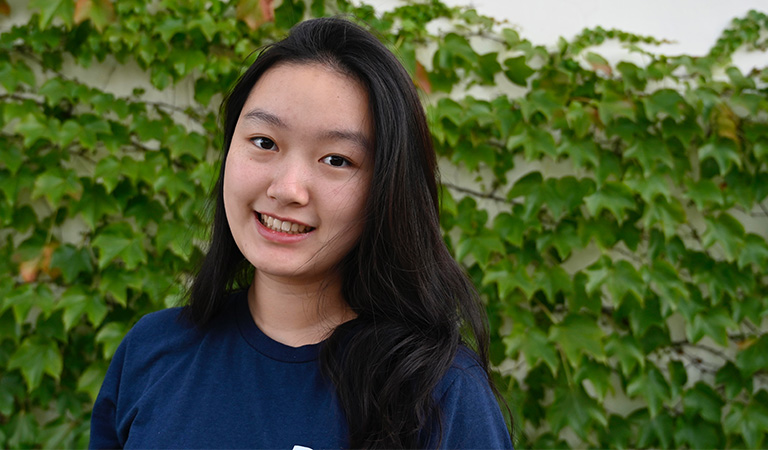Laurie Luo ’25: Charting a Path From Mathcamp to Mudd
December 1, 2023
When she was in high school, Laurie Luo ’25 met Harvey Mudd College mathematics professor Michael Orrison, who was teaching a course at the 2019 Canada/USA Mathcamp, an immersive summer experience for mathematically talented teenagers from around the world. Though she only had one class with him, she was so inspired by his ability to clearly explain graduate-level mathematics that she decided to apply to HMC.
Now a CS and math major in her junior year at Mudd, Luo is fully immersed in the “beautiful world of mathematics.” She’s co-authored papers about quasi-cluster algebras, Kac-Moody algebras and, recently, “Number of triangulations of a Möbius Strip,” which was published this year in the mathematics journal Involve.
“As shown in the paper,” says Luo, who is interested in cluster algebras, “the number of triangulations on a Möbius Strip is a counting problem, and the answer is unique. There is no premise of the research, since the research arises from a focused in an established field.”
Here, Luo shares her thoughts on this research and on how she discovered mathematics.
Math for Math’s Sake: Navigating Through Its Own, by Laurie Luo
“Put your thumb here and your fingers there,” my dad explained. I was four years old, and he was teaching me to count the 10,000 Chinese Yuan in bills that he’d placed on the table before me. However, I was not interested in business. Instead, the process of counting itself interested me more. At that time, I never knew that I would enter the beautiful world of mathematics and stay for years.
My relationship with math took off after a failure: my team earned only a participation award in the high school math contest in modeling in 10th grade. Still amazed to discover matrices’ god-like ability to solve many seemingly unrelated things, I decided to dive deeper. Later, I learned how each coefficient, each assumption matters: with a small dataset, a time series model may be better than a more advanced-seeming neural network; sometimes, linear programming has no solution or requires 1,000 years to run the program.
I realized definitions, not proofs, are the most essential part of math at the Canada/USA Mathcamp. After camp, I researched the number of triangulations on a Mobius strip, the only finite type in quasi-cluster algebra, with n marked points. The research seemed easy at first; however, as n became larger, the problem haunted me. Was there a pattern hidden in the sequence? I tried new approaches daily, gluing and transforming the Mobius strip.After months of work, my mentor, my co-researcher and I came up with an iterative formula. However, the formula wasn’t “elegant” enough, so we took another two months to find a cleaner way to express it. The more we knew, the more problems arose, so the research never ended in discovering the bases of quasi-cluster algebra. From counting the amount of money to counting triangulations on a Mobius strip, the eternity of math feeds my spirits.
As I entered Harvey Mudd College, I focused more on analyzing computer science algorithms. I joined the AMISTAD Lab to research the vectorization of bias for continuous machine learning models. The theoretical aspects of the problem were intriguing, yet the sheer magnitude of data presented unique challenges. This led us to innovative approaches in representing our continuous search space: by making thoughtful assumptions and justifying simplifications, we were able to represent our findings more effectively, ultimately storing these vectors as probability distributions using kernel density estimation.
Currently, as an AI research intern at a biotech company, I delve into the complexities of genomic data, seeking harmony amidst its variations. My days are spent in meticulous analysis, modeling patient outcomes through the lens of longitudinal whole genome sequencing and refining the intricacies of bioinformatics pipelines for enhanced efficiency. As each puzzle piece falls into place, my anticipation grows for the next chapter of my journey as a quantitative research intern. I look forward to exploring new challenges, blending my love for mathematics with the practical demands of the industry, and continuing my pursuit of elegant solutions in the tapestry of data.
